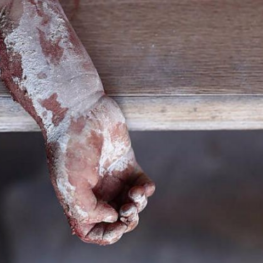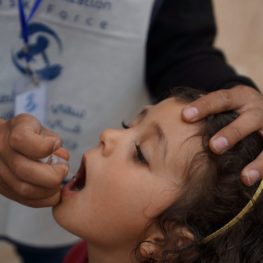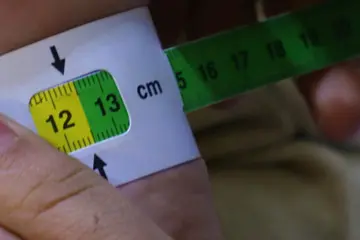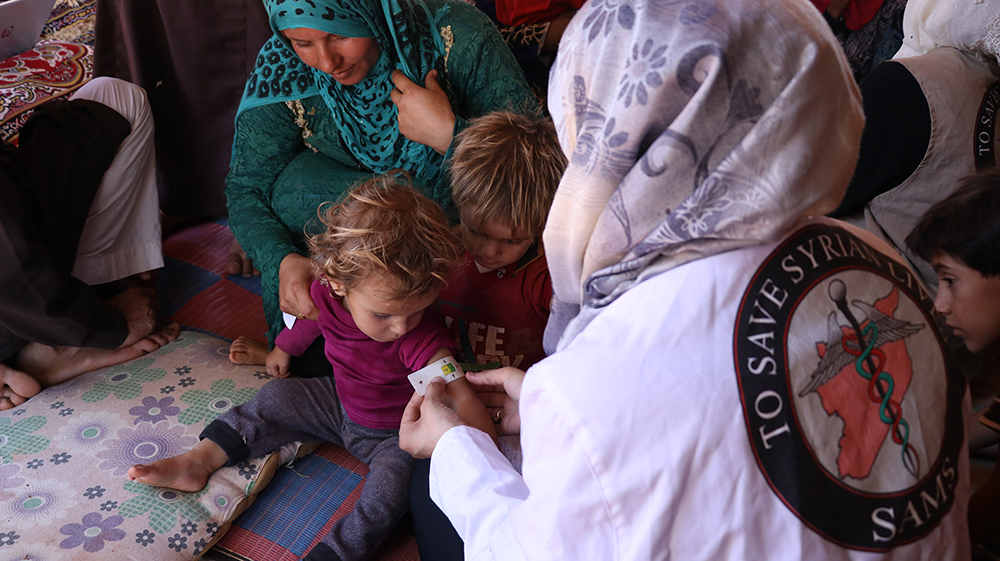July 25, 2017
Dr. Nour is a Syrian pediatrician working with the Syrian American Medical Society (SAMS). For four years, she has been practicing within conflict zones inside Syria. She recently spoke at a UN OHCHR/WHO Meeting on Child Mortality in Geneva. She shared with us her remarks from the meeting, detailing attacks on health care and how they have affected health services for children, as well as the scope of child mortality in Syria, the need for immunization programs and screening.
Children in conflict zones are in need of more care due to displacement, injuries and the lack of adequate health care.
 In Syria, we are incapable of offering the necessary care for several reasons; most prominently the lack of medical centers as a result of the destruction, and the inability of existing staff to cover more medical centers. There are 1,000 pediatric doctors working in Syria – one quarter of which are specialists. This means that each doctor is responsible for caring for 6,000 children in the areas outside the control of the Syrian government. Another obstacle for children in need is the difficulty of reaching and accessing health care centers. Many patients are afraid to come to our hospitals because of the fact that medical facilities have become a deliberate target of bombing.
In Syria, we are incapable of offering the necessary care for several reasons; most prominently the lack of medical centers as a result of the destruction, and the inability of existing staff to cover more medical centers. There are 1,000 pediatric doctors working in Syria – one quarter of which are specialists. This means that each doctor is responsible for caring for 6,000 children in the areas outside the control of the Syrian government. Another obstacle for children in need is the difficulty of reaching and accessing health care centers. Many patients are afraid to come to our hospitals because of the fact that medical facilities have become a deliberate target of bombing.
In April 2017, the central hospital in Ma’ara in northern Syria was bombed. Some surviving children’s parents preferred to take their children home although they still needed to be treated, so that they would not be subjected to bombardment again. A mother once told me, while I was trying to convince her that her daughter was still in need of treatment: “If death is destined for my child, I want her to die in one piece.”
Another serious problem we encounter in Syria is the diminished capacity of hospitals and emergency centers, especially when dealing with mass casualties or chemical weapons attacks. You can imagine what it means to have more than 100 injured people hospitalized at the same time in an ill-equipped underground field hospital. You can imagine what it means to have more than 1000 cases of asphyxiation, mostly children, gasping for their lives after a chemical attack, in an area with no centers properly equipped to deal with these cases.
 It is essential that active medical centers conduct a nutritional screening for all patients, as malnutrition is the cause of thirty-five percent of under-five child mortality. Additionally, there is an immediate need to support vaccine centers with required vaccines, mobilize the community to accept these vaccines, and oblige all involved parties to implement routine vaccination programs. As the vaccination process faces many difficulties, the most important of which is the lack of adequate coverage for conflict areas across Syria, and this was the reason for the last polio epidemic. Secondly, the people lost trust in the international community, they say “protect us from death before protecting us from disease”, which resulted in diseases that could have been prevented.
It is essential that active medical centers conduct a nutritional screening for all patients, as malnutrition is the cause of thirty-five percent of under-five child mortality. Additionally, there is an immediate need to support vaccine centers with required vaccines, mobilize the community to accept these vaccines, and oblige all involved parties to implement routine vaccination programs. As the vaccination process faces many difficulties, the most important of which is the lack of adequate coverage for conflict areas across Syria, and this was the reason for the last polio epidemic. Secondly, the people lost trust in the international community, they say “protect us from death before protecting us from disease”, which resulted in diseases that could have been prevented.
People in conflict zones think only about survival and securing food; therefore, our children are deprived of their most important rights, namely to be children. Aisha, a 10-year-old girl, was my patient in western Aleppo countryside, where she visited me with her three younger sick siblings. When I told her she had to bring one of her parents or her caregiver, she put her head down and said: “I care for these children, my mother died when my younger brother was one week old, my father abandoned us, I am responsible for my siblings, they have no one else but me.” I mention this story to show the importance of building children’s rights as part of Syria’s post-crisis reconstruction.
 Children of Syria need your support; they need the creation of orphanages to accommodate them, they need child-friendly centers established to restore psychological trauma caused by conflict, and to find a safe space for them to express the stress they continue to endure. Emphasis must be placed on the role of education as an important part of building a viable generation by providing safe schools – I emphasize this word, safe, as one out of every four schools in Syria is either totally or partially damaged.
Children of Syria need your support; they need the creation of orphanages to accommodate them, they need child-friendly centers established to restore psychological trauma caused by conflict, and to find a safe space for them to express the stress they continue to endure. Emphasis must be placed on the role of education as an important part of building a viable generation by providing safe schools – I emphasize this word, safe, as one out of every four schools in Syria is either totally or partially damaged.
As we all know, the greatest proportion of under-five child mortality is around birth. This is why we must give this age greater attention. This can be achieved through providing health education programs for pregnant women and providing adequate centers with sufficient capacity for incubators and ventilators, proportional to the number of births. On a daily basis, there are 300 deliveries in areas outside of regime control. Hospitals do not have the necessary facilities to care for these births, so a premature child would be vulnerable to death because of the lack of resources. Moreover, most parents are unwilling to transfer their children to neighboring countries that have the necessary medical equipment to avoid the agonies of being refugees.
I also point to our need to provide a neonatal screen , which reduces mortality and preventable diseases. The screen increases the ability to determine the cause of certain deaths and preventing them, especially if the cause is genetic and repeatable, through advising parents.
I am here to say, our children in Syria thank you for your support as international committees. However, they demand more attention to match the magnitude of the humanitarian crisis they are experiencing.



